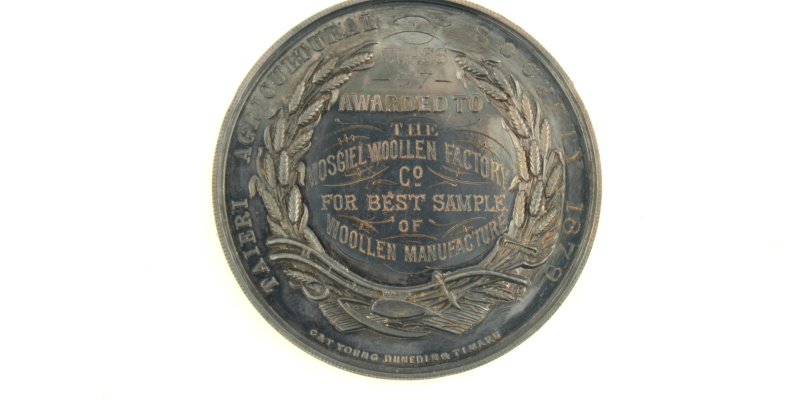
Preparing updates to our Southern Land Southern People gallery has proven to be a great stimulus to do extra research on the stories behind the items on display.
This week I’ve been looking at the medals won by the Mosgiel Woollen Factory Company in 1879 and 1880. Two are from the Taieri Agricultural Society shows where it was estimated that over 1,400 adults attended. There’s a third from the Canterbury A & P Association.

The objectives of the Taieri Agricultural Society included ‘the promotion of those arts with which agriculture and the rearing of stock are associated’, and it was agreed that annual competitions were an important way of achieving this aim.
The Mosgiel Woollen Factory was founded by Arthur Burns in 1871 and became a public company in 1873. One of Mosgiel’s founding fathers, Burns named the town after his great-uncle the poet Robert Burns' farm Mossgiel in Ayrshire, Scotland. Burns also served the Taieri Agricultural Society in various capacities, including having their first ploughing match take place on his farm.
There is a wonderfully detailed account of the factory by a visiting reporter published in The Colonist in1878. (The original clipping can be viewed on Papers Past). At that time it occupied a site of just over six hectares, and the complex included 24 working men’s cottages and a manager’s house as well as buildings for the carding engines, the boiler, a wool store, dyestuffs store, and the separate stocking and hosiery factory. Mosgiel produced 50 dozen socks and over 3,500 metres of tweed fabric per week at that time. They also made ‘shawls, blankets, plaidings, cricket flannels, and yarns of all kinds… and hosiery’.

The company employed 100 people in 1878 but was about to increase staff numbers to 120. Male employees were paid £2 to £4 per week; the ‘girls’ less than half that.
Their Taieri Agricultural Society silver medals were the first prize for ‘Best Sample of Woollen Manufactures’ in two consecutive years. Both local and international recognition was important for reputation and sales. In the early days of his New Zealand Clothing Company, for example, Dunedin businessman Bendix Hallenstein used fabric from Dunedin’s mills. As well, at the company’s Annual Meeting for 1879, the Chairman read a report of the recent Sydney International Exhibition, which said the Mosgiel Factory’s ‘goods were splendidly finished… and there was one piece of saddle tweed which was the admiration of all who saw it... The flannels and blankets were excellent, and so was the hosiery’.
Sadly, Mosgiel was placed in receivership in 1980.
The medals are on display in the Southern Lands Southern People gallery, together with an iconic Mosgiel travel rug and woollen fabric sample. Photos of the factory and its workers are held in the Hocken Collections and can be viewed online.


